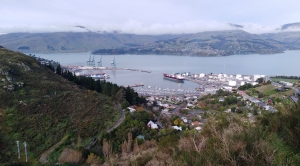


(Posted on 20/08/18)
OMC International, the world leader in under-keel clearance technology for ports and harbours, has helped Lyttelton Port Company (LPC) significantly reduce the volume of dredging required to upgrade the Port’s entrance channel, through use of Dynamic Under Keel Clearance (DUKC) technology.
Later this month one of the world's largest dredgers will start work enlarging the entrance channel to Lyttelton Port, New Zealand. In Stage 1 of the project the existing 7km shipping channel will be lengthened by 2.5km, widened by 20m and deepened to increase maximum vessel draughts from 12.4m to 13.3m. The project is the result of more than two years of careful planning and stakeholder consultation by LPC.
As well as providing the largest Port and container service in New Zeeland’s South Island. Lyttelton Port is has facilities for loading and unloading bulk products such as fertiliser, gypsum, cement, logs, conventional break-bulk, imported vehicles and petroleum.
LPC Chief Executive Peter Davie said dredging of the shipping channel “will enable larger ships to call at Lyttelton Port providing Canterbury’s importers and exporters the best possible and most cost effective international shipping solutions”.
As part of the Port's commitment to minimise the environmental impacts of the project and provide an efficient service to its stakeholders, LPC engaged OMC International to review the preliminary channel design and determine optimum channel depths required to allow the larger ships to safely transit to and from the Port.
"OMC provided LPC with two alternative channel design profiles," Project Director Martin Watts said. "The first design was the most efficient design that could be achieved if LPC continued to use traditional methods for managing the under-keel clearance of deep-draught vessel transits. The second design was based on applying a more scientific decision-making process using OMC's DUKC system.
“LPC evaluated the costs and benefits of the two approaches and the outcome was clear: The decision to adopt the DUKC system has allowed LPC to reduce the dredging volume required for Stage 1 of the deepening project by more than 40% compared with initial estimates, which were based on standard industry guidelines.
“Adoption of DUKC will provide the port with a significant reduction in capital dredging costs and ongoing operational benefits through wider vessel sailing windows and a reduced risk of vessels grounding under severe conditions."
Channel dredging should be completed by November and Lyttelton Port expects to be able to accommodate deeper vessels by the end of 2018 when the new navigation aids, and DUKC system, will be installed and operational.
The Trois-Rivières Port Authority (TRPA) in Canada has announced the appointment of Mr. Anick... Read more
Euroports commitment to continuously improving operational efficiency, enhancing workplace safety, and... Read more
Under the slogan ‘Your Intermodal Link Between China, Iberia and the Atlantic Markets,’... Read more
Port of Hamburg Marketing (HHM) continues to strengthen its successful cooperation with Chinese port... Read more
Total throughput in the port of Rotterdam fell slightly by 2.6% in the third quarter of 2025 compared... Read more
E-Crane Asia has announced a major milestone achieved by Bayan in Indonesia: the company’s three... Read more
PD Ports has successfully introduced fully automated weighbridge systems at Teesport and Hartlepool,... Read more
In the first nine months of 2025, Port of Antwerp-Bruges handled 202.6 million tonnes of maritime goods... Read more
The 90th General Assembly of the inland shipping cooperative NPRC has highlighted the importance of... Read more
The Bilbao Port Authority has obtained the highest score in the second evaluation of the Mandatory Information... Read more